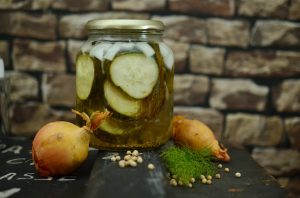 So what foods come to mind with fermentation? You might think sauerkraut, pickles, cheese, jerky, yogurt or even beer. From other cultures we have a spicy cabbage mixture, kimchi and fermented beans referred to as tempeh.
So what foods come to mind with fermentation? You might think sauerkraut, pickles, cheese, jerky, yogurt or even beer. From other cultures we have a spicy cabbage mixture, kimchi and fermented beans referred to as tempeh.
Why the interest in home fermentation? And, what are the risks?
Consider how this method of food preservation got started. Fermentation was not invented, but discovered. Probably a few of our ancestors left a few grains of barley out in the rain; some microorganisms who knew a good thing was coming fermented the starch, turned it to sugar and then to alcohol. The same might have happened to turn fruit juice into wine and cabbage into sauerkraut.
Fermentation became a valuable food preservation method. In the case of kimchi or sauerkraut, salt is used to preserve the vegetables. The bacteria that remain, called lactobacillus, convert sugars and carbohydrate into lactic acid and give them the tangy flavor that people have come to associate with these foods.
These bacteria are called probiotics and are thought to be good for our digestive system. Although probiotics are showing up in the news and the supermarket, it is still unknown how much is needed to be beneficial or how these bacteria live and colonize in the gut.
Although fermented foods present a number of benefits, we need to be wary of the home fermentation of vegetables because good food safety practices must be in place. Food that is selected for fermentation needs to be clear of coming in contact with manure or compost that might have been contaminated with E.coli or Salmonella.
Salt is an essential ingredient, and since consumers don’t usually have a reliable way to measure salt concentration in the finished product, they need to measure salt carefully and follow a tested recipe. Canning and pickling salt is the salt to use; table salt, kosher salt, or other types of salt cannot be interchanged with canning and pickling salt. Also, salt with iodine added shouldn’t be used since iodine can inhibit fermentation as well as darken the food product.
Proper temperature is also important. According to USDA, at temperatures between 70-75º F kraut will be fully fermented in about three to four weeks; at 60-65º F fermentation may take five to six weeks. At temperatures lower than 60º F, kraut may not ferment. Above 75º F kraut may become soft.
Fermentation of vegetables can be done in your own home, but look for recipes from trusted sources. And save your ideas for modifying a recipe for your next cookie or salad recipe, not for fermented foods.
For a basic how to about home fermentation of food, check out the National Center for Home Food Preservation and look up ‘fermented foods’ .

